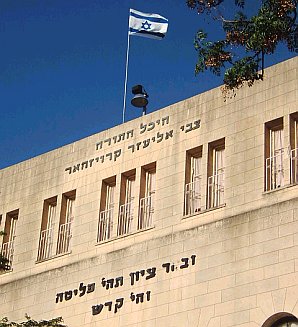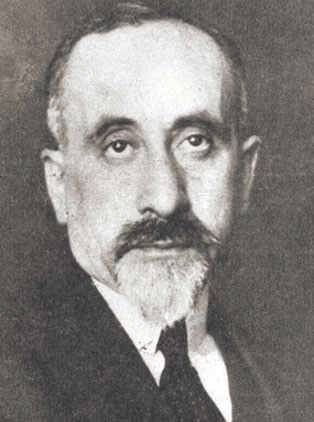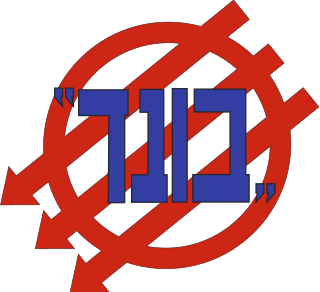Related Research Articles

United Torah Judaism, often referred to by its electoral symbol Gimel, is a Haredi, religious conservative political alliance in Israel. The alliance, consisting of Agudat Yisrael and Degel HaTorah, was first formed in 1992, in order to maximize Ashkenazi Haredi representation in the Knesset. Despite the alliance splitting in 2004 over rabbinical differences, the parties reconciled in 2006, in order to prevent vote-wasting. In April 2019, the party achieved its highest number of seats ever, receiving eight seats.

Agudat Yisrael is a Haredi Jewish political party in Israel. It began as a political party representing Haredi Jews in Poland, originating in the Agudath Israel movement in Upper Silesia. It later became the party of many Haredim in Israel. It was the umbrella party for many, though not all, Haredi Jews in Israel until the 1980s, as it had been during the British Mandate of Palestine.
World Agudath Israel, usually known as the Aguda, was established in the early twentieth century as the political arm of Ashkenazi Torah Judaism. It succeeded Agudas Shlumei Emunei Yisroel in 1912. Its base of support was located in Eastern Europe before the Second World War but, due to the revival of the Hasidic movement, it included Orthodox Jews throughout Europe. Prior to World War II and the Holocaust, Agudath Israel operated a number of Jewish educational institutions throughout Europe. After the war, it has continued to operate such institutions in the United States as Agudath Israel of America, and in Israel. Agudath Israel is guided by its Moetzes Gedolei HaTorah in Israel and the USA.

Rabbinic authority in Judaism relates to the theological and communal authority attributed to rabbis and their pronouncements in matters of Jewish law. The extent of rabbinic authority differs by various Jewish groups and denominations throughout history.
The Folkspartei was founded after the 1905 pogroms in the Russian Empire by Simon Dubnow and Israel Efrojkin. The party took part in several elections in Poland and Lithuania in the 1920s and 1930s and did not survive the Holocaust.

Yaakov Yisrael Kanievsky, known as The Steipler or The Steipler Gaon, was a Haredi rabbi, Talmudic scholar, and posek ("decisor" of Jewish law), and the author of Kehilos Yaakov, "a multi-volume Talmudic commentary".

Elazar Menachem Man Shach was a Haredi rabbi who headed Misnagdim Orthodox Jews in Israel and around the world from the early 1970s until his death. He served as chair of the Council of Sages and one of three co-deans of the Ponevezh Yeshiva in Bnei Brak, along with Shmuel Rozovsky and Dovid Povarsky. Due to his differences with the Hasidic leadership of the Agudat Yisrael political party, he allied with Ovadia Yosef, with whom he founded the Shas party in 1984. Later, in 1988, Shach criticized Ovadia Yosef, saying that, "Sepharadim are not yet ready for leadership positions", and subsequently founded the Degel HaTorah political party representing the Litvaks in the Israeli Knesset.

Zorach or Zorah Wahrhaftig, also known as Zerach Warhaftig, was an Israeli rabbi, lawyer, and politician. He was a signatory of Israel's Declaration of Independence.

From the founding of political Zionism in the 1890s, Haredi Jewish leaders voiced objections to its secular orientation, and before the establishment of the State of Israel, the vast majority of Haredi Jews were opposed to Zionism, like early Reform Judaism, but with distinct reasoning. This was chiefly due to the concern that secular nationalism would redefine the Jewish nation from a religious community based in their alliance to God for whom adherence to religious laws were “the essence of the nation’s task, purpose, and right to exists,” to an ethnic group like any other as well as the view that it was forbidden for the Jews to re-constitute Jewish rule in the Land of Israel before the arrival of the Messiah. Those rabbis who did support Jewish resettlement in Palestine in the late 19th century had no intention to conquer Palestine and declare its independence from the rule of the Ottoman Turks, and some preferred that only observant Jews be allowed to settle there.
Isaac Breuer was a rabbi in the German Neo-Orthodoxy movement of his maternal grandfather Samson Raphael Hirsch, and was the first president of Poalei Agudat Yisrael.

The history of the Jews in Antwerp, a major city in the modern country of Belgium, goes back at least eight hundred years. Jewish life was first recorded in the city in the High Middle Ages. While the Jewish population grew and waned over the centuries, by the beginning of World War II Antwerp had a thriving Jewish community comprising some 35,000, with many Jews connected to the city's diamond industry. The Nazi occupation of Antwerp from 1940 and The Holocaust decimated the city’s Jewish population. By the time of Antwerp's liberation in September 1944, the Jewish population had fallen to around 1,200.

Henryk Ehrlich Yiddish: הענריק ערליך), sometimes spelled Henryk Erlich; 1882 – 15 May 1942) was an activist of the General Jewish Labour Bund in Poland, a Petrograd Soviet member, and a member of the executive committee of the Second International.

The General Jewish Labour Bund in Romania was a Jewish socialist party in Romania, adhering to the political line of the General Jewish Labour Bund. Founded in 1922, shortly after the establishment of Greater Romania, it united Jewish socialists in Bukovina, Bessarabia and the Romanian Old Kingdom. Standing for the lay wing of the Jewish representative movement, the Romanian Bund had atheistic leanings and offered an alternative to the mainstream Jewish organization. Like other Bundist groups, but unlike the Marxist-inspired Poale Zion bodies of Bessarabia, it rejected Zionism.

The Arbeter-ring in Yisroel – Brith Haavoda was the Israeli branch of the International Jewish Labor Bund, launched in 1951 and disbanded in 2019.

The General Jewish Labour Bund in Poland was a Jewish socialist party in Poland which promoted the political, cultural and social autonomy of Jewish workers, sought to combat antisemitism and was generally opposed to Zionism.

Yeshivas Knesses Yisrael was a yeshiva located in the town of Sloboda Vilyampolskaya in Kovno Governorate of Russian Empire. It functioned from the late 19th century until World War II.

Bundism was a secular Jewish socialist movement whose organizational manifestation was the General Jewish Labour Bund in Lithuania, Belarus, Poland, and Russia, founded in the Russian Empire in 1897.

Esther Frumkin, born Malkhe Khaye Lifshitz and also known as Mariya Yakovlevna Frumkina, was a Belarusian Bundist revolutionary and publicist and Soviet politician who served as leader of the General Jewish Labour Bund in Lithuania, Poland and Russia, and later of the Yevsektsiya in the Soviet Union. An ardent proponent of the Yiddish language, her political position on Jewish assimilation satisfied neither traditional Jews nor the Soviet leaders.

The General Jewish Labour Bund in Lithuania, Poland and Russia, generally called The Bund or the Jewish Labour Bund, was a secular Jewish socialist party initially formed in the Russian Empire and active between 1897 and 1920. In 1917 the Bund organizations in Poland seceded from the Russian Bund and created a new Polish General Jewish Labour Bund which continued to operate in Poland in the years between the two world wars. The majority faction of the Russian Bund was dissolved in 1921 and incorporated into the Communist Party. Other remnants of the Bund endured in various countries. A member of the Bund was called a Bundist.
References
- ↑ Henry Abramson, The end of intimate insularity: new narratives of Jewish history in the post-Soviet era, in Acts of Symposium “Construction and Deconstruction of National Histories in Slavic Eurasia,” at Sapporo, Japan, on July 10–13, 2002
- ↑ Stopnicka Heller, Celia (1993). On the edge of destruction: Jews of Poland between the two World Wars. Wayne State University Press. p. 383. ISBN 978-0-8143-2494-3 . Retrieved 2009-12-01.
- 1 2 Gitelman, Zvi Y. (2003). The emergence of modern Jewish politics: Bundism and Zionism in Eastern Europe. Univ of Pittsburgh Press. p. 275. ISBN 978-0-8229-4188-0 . Retrieved 2009-12-04.
- ↑ Bacon, Gershon C. (1996). The politics of tradition. Agudat Yisrael in Poland 1916-1939. Studies on Polish Jewry. Jerusalem: The Magnes Press, The Hebrew University of Jerusalem. p. 331. ISBN 965-223-962-3., pp.200, 220-222
- ↑ "Kehillah". Wordnik.com. Retrieved 2023-05-23.
- ↑ Talmud , b. Sanhedrin 17b:10